Clouds in Art—Stratus, Cumulus, Cirrus, and Many More!
Clouds in art are why the term “landscape painting” is a bit deceiving. It suggests that the subject of the artwork is the land, and yet it is...
Sandra Juszczyk 25 July 2024
Ever since men first went to war in airplanes, they have felt the need to decorate their machines with unofficial, often banned and personal markings. So-called Nose Art created a powerful bond between man and machine. Pilots wanted to see their airplanes as almost human entities with which they could identify. Especially when they faced danger, they even wanted to endow their war-birds with superhuman qualities to protect them and bring them safely back.
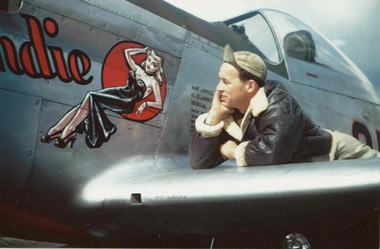
Nose Art is a type of art that gives each plane a personality, thus setting it apart from all the other crafts that came down the same assembly line. These colorful decorations are compared to a sophisticated graffiti of the 20th century. They are called Nose Art because of their position on the fuselage of the aircraft.
The images, mostly those on historic aircraft, were morale-boosting, good-luck charms, and also reminders of a pilot’s personal life, hobbies, characteristics, and much more. Often they had political meaning as well, with a propaganda purpose, or served as a way to mock the enemy. The practice of decorating the sides of an aircraft with pictures and words did not always have official approval.
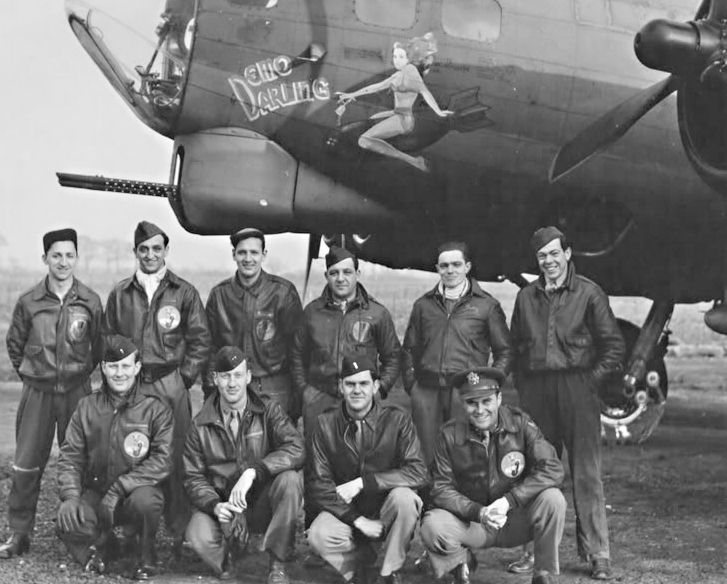
Often it didn’t even have to be Nose Art or paintings in general, with which pilots decorated and distinguished their planes. Some pilots who were successful in the air didn’t have much in the way of drawing skills or didn’t want to draw something. So, instead of drawing they just put an inscription on the plane and in this way named it.
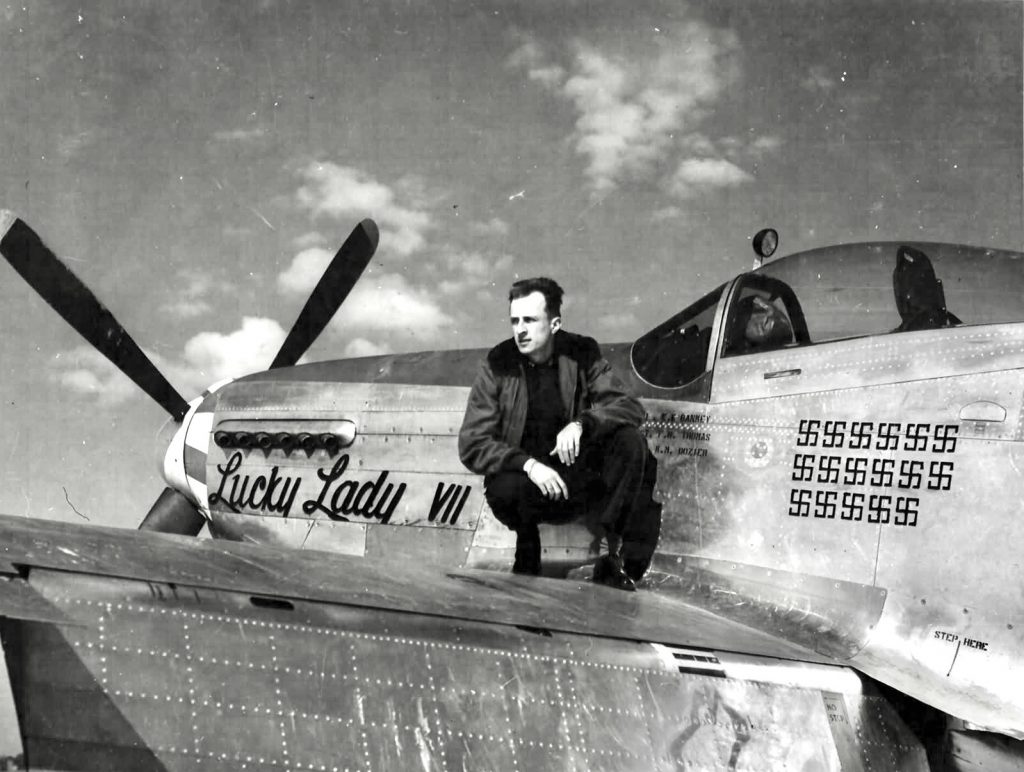
For them, the plane was a kind of woman who temporarily replaced their wife at home, and so they treated the plane as their “lady”. They treated the plane with respect for sentimental reasons. They were also superstitious because they were afraid of it betraying them when they needed it in their struggle for survival. Subsequently many pilots drew a four-leaf clover on their planes to bring them luck and happiness in the air.
Nose Art traces its origins to the First World War. It had a very practical purpose – visual markings were needed to separate friendly craft from foe. The first symbols were formal and used variations of national colors and icons already in use. These identifying symbols, typically painted on the tails and fuselages of aircraft, were soon joined by other markings indicating the number of missions or kills completed by the aircraft as well as other personal drawings. Nose art marking became a form of differentiation of a particular airplane and typically the pilot sitting in it became famous for his individual victorious successes in dog fights or air battles. In this way the military and civilian public knew the pilot’s name and what his machine looked like.
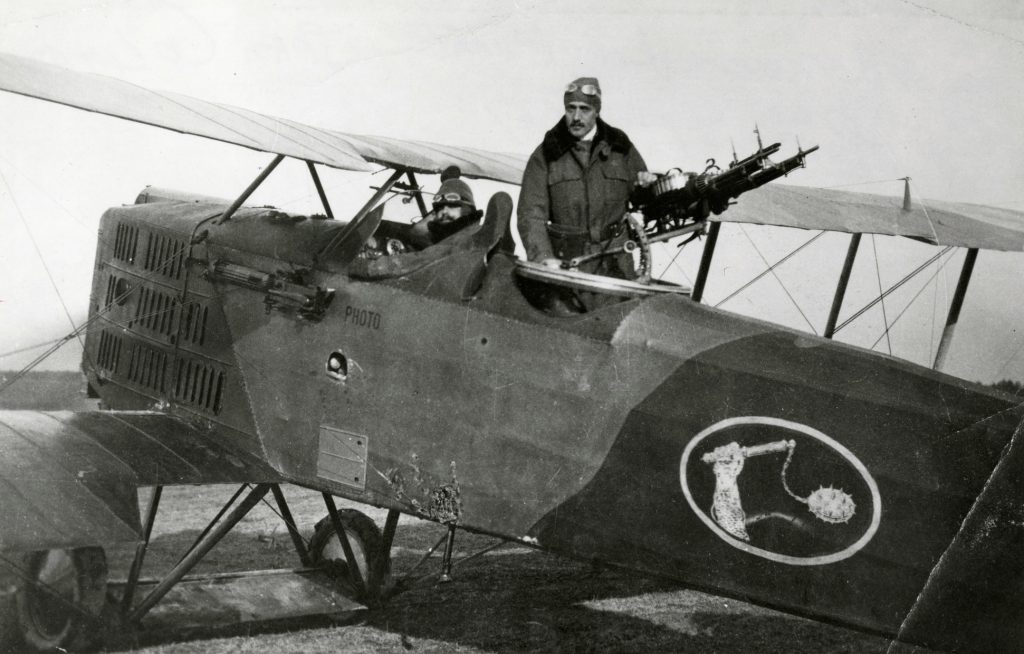
Placing personalized decorations on fighting aircraft began with German, French, and Italian pilots. One of the most interesting and famous examples is the Red Airplane of Baron Manfred von Richthofen, known as the “Red Baron”. The German pilot was considered the ace-of-aces of the war and started an era or cult of personal success and individuality as a pilot in the so-called dog fights. With a desire to be different, to emphasize the contrast of the plane with the sky, and to spread his glory in the air in the consciousness of the enemy, the Baron personalized his airplane by painting it all red. Hence he got his nickname, Red Baron. Richthofen’s story has been filmed and if you are interested you can watch the trailer here.
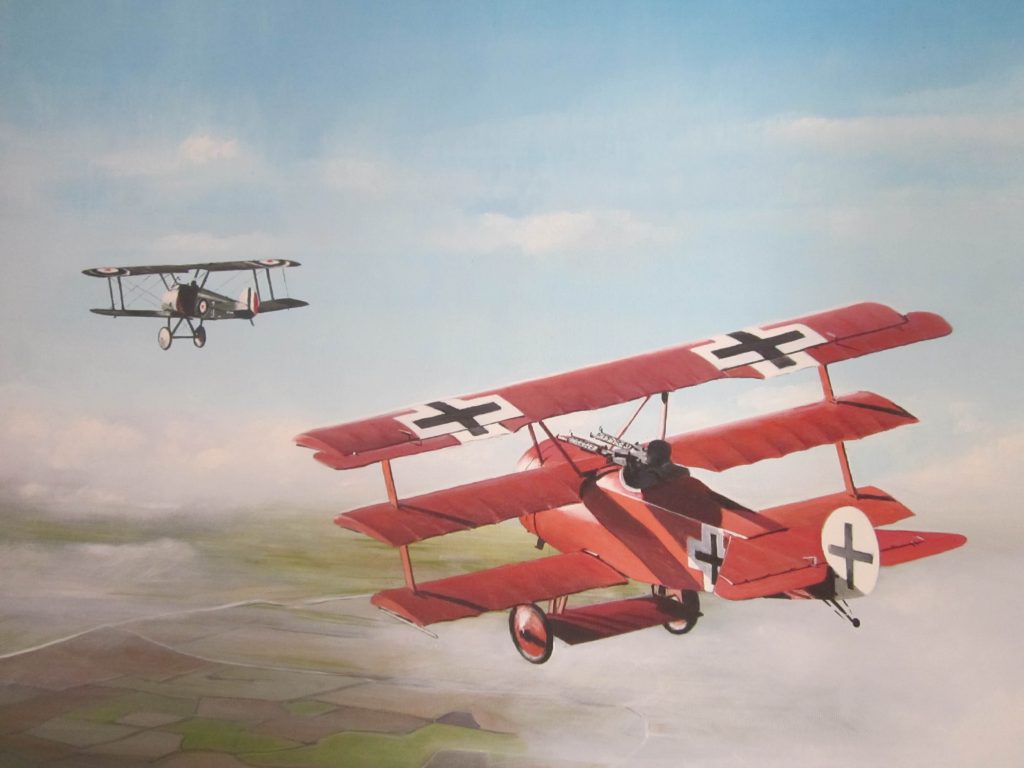
Other pilots wanted to be different and began painting various symbols, motifs, mascots, numbers, or family coats of arms on their planes. In this way, they wanted to specify their way of fighting, tactics, or even aristocratic origin. By personalizing their aircraft they aimed to separate themselves from some kind of uniformity. Count Francesco Baracca, Italy’s top fighter ace of WWI, wore an emblem of a black horse a so-called cavallino rampante which later inspired Enzo Ferrari to use it on his racing cars.
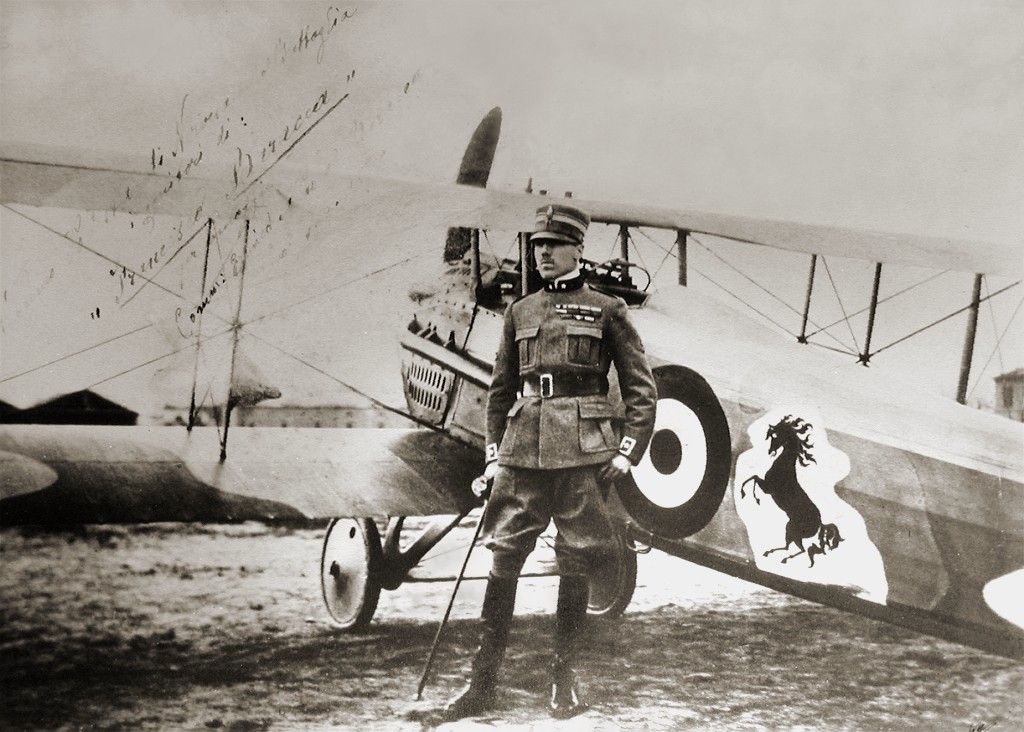
At its most basic, Nose Art painting enhanced a physical feature of the aircraft. That is the reason why German pilots were the first to come up with the most distinctive and specific forms of differentiation. They transformed these features into menacing images, with a shark or tiger mouth being the most common. They took advantage of the shape of the entire aircraft so that both the animal and the plane become one menacing entity. The first noted “Shark mouth” was on the German Roland C.II. (Revell), aircraft commonly referred to as the Walfisch (or Whale).
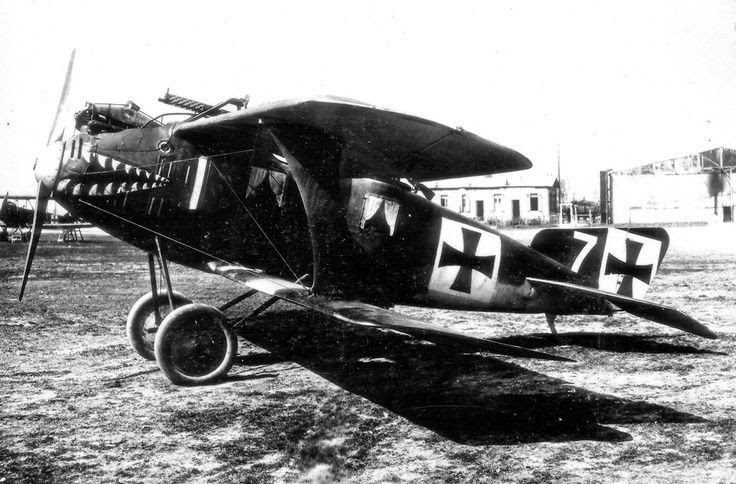
By giving the plane the face of an animal, it was supposed to evoke in the enemy the feeling that Germans were predators who went hunting for their prey. With this marking, as part of a tradition, Germans continued until the formation of the Luftwaffe during WWII.
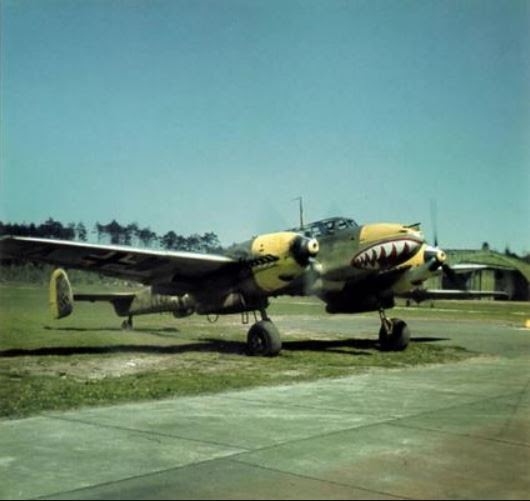
When German aircraft Messerschmitt Bf 110s encountered the RAF 112 Squadron in the North African desert, the same design of the shark mouth appeared in July 1941 on the Curtiss P-40 Tomahawk. This American aircraft was given to the Royal Air Force as a form of assistance in combating their common enemy. British pilots also used the shark mouth on their P-40s as a manifestation of rival inspiration.
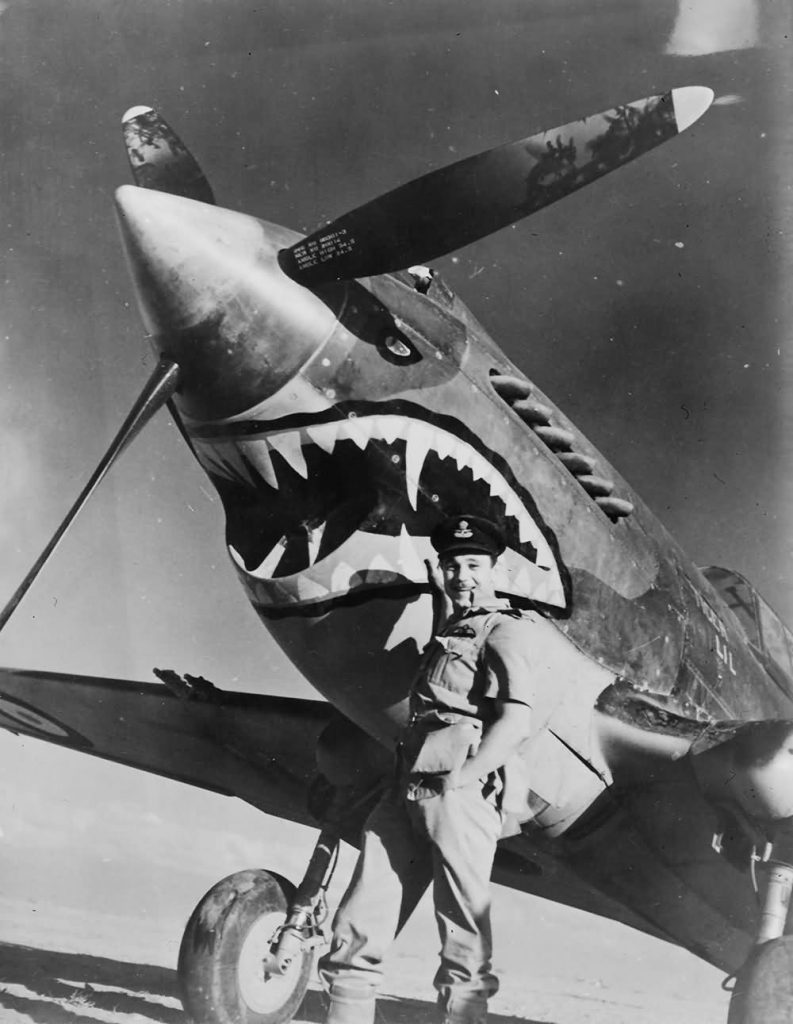
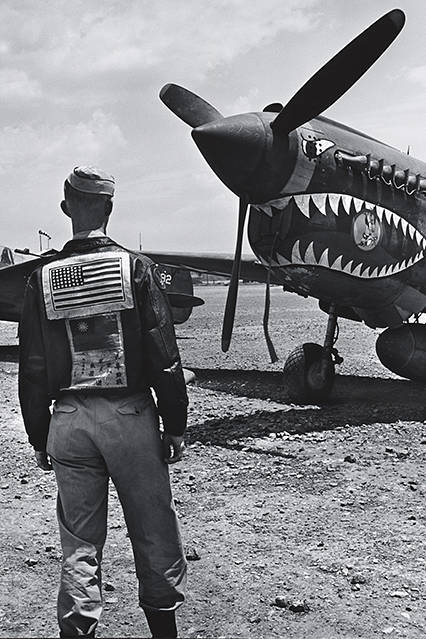
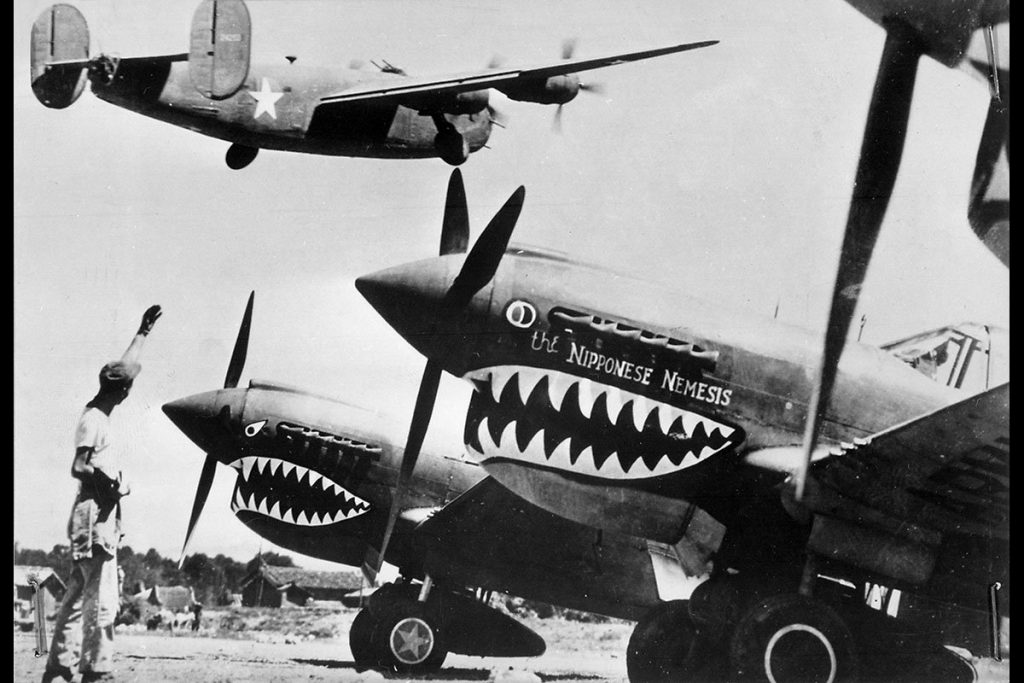
However, the unit which became most famous for their use of the shark’s mouth was the American Flying Tigers. They were a group of volunteers who flew from China on American Curtiss P-40 aircraft and made raids on Japan in 1941-42. During their missions throughout the Pacific and over Japanese territory, they recorded such a high number of successful shots and victorious battles that they made the name of their squadron famous. The entire squadron painted their planes with shark’s teeth, which was the hallmark of their enemy.
The Flying Tigers have also become icons in pop-culture and the fashion industry having attracted attention with their Shark mouth Nose Art design. Brands like Alpha Industries used the shark mouth or Flying Tiger name in many designs and to this day everyone associates the shark teeth logo with the Flying Tigers.
It didn’t take long, for Nose Art to become real works of art. The phenomenon of Nose Art finds its best expression on American military aircraft during the Second World War which is considered its golden age.
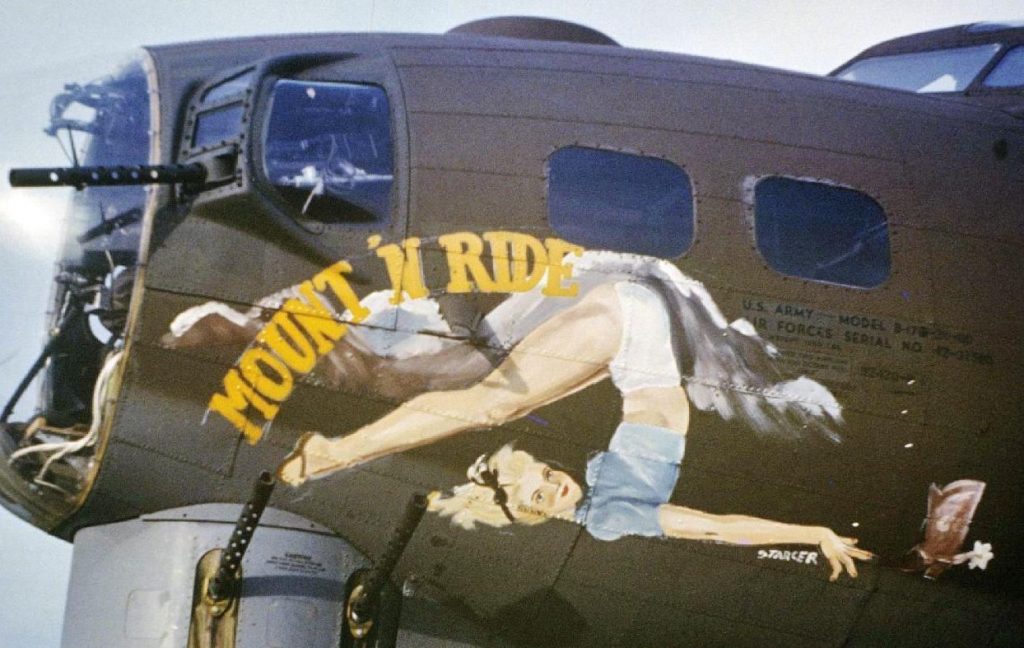
Each piece of Nose Art is a window into the history and the lives of the airmen. It gave an identity to a pilot or a crew and the particular aircraft that they depended on for their lives. WWII is when the art form really picked up a name for itself. Early in the war, before the Battle of Britain, the RAF was receiving young men from all over the world and they started to paint their nationality. By the beginning of 1941, it took the name Nose Art for the simple reason that it was the only position on the aircraft where they could paint without interfering with markings, identification, or serial number.
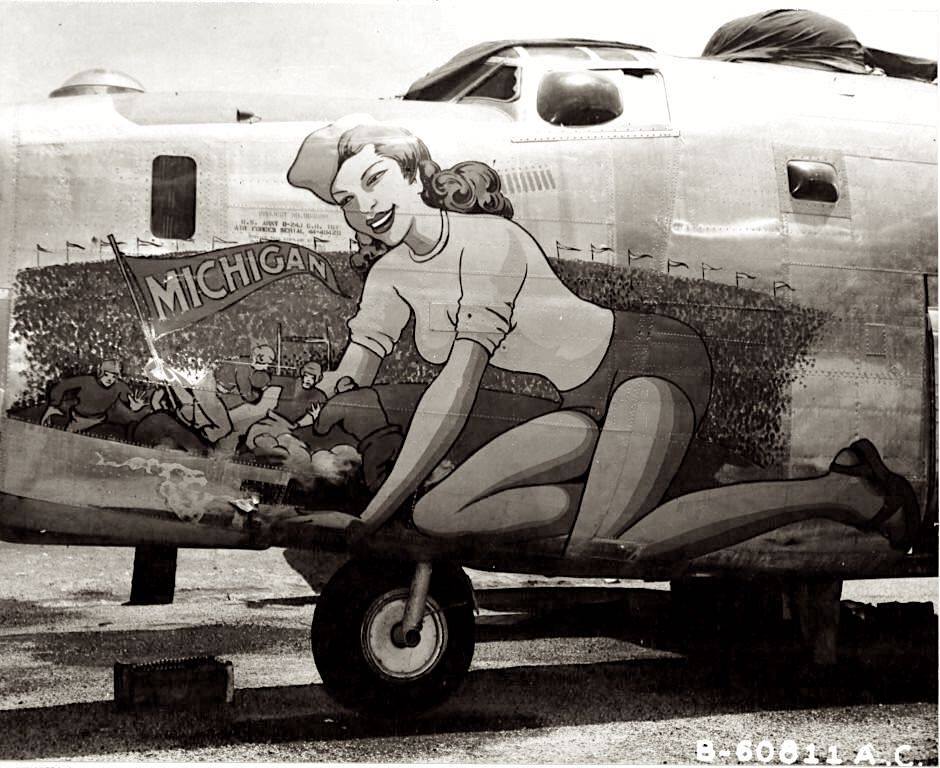
However, American pilots contributed the most in making Nose Art famous. Using their own creativity they painted unforgettable images and motifs which are still remembered even though many of them were not captured in photographs or no longer exist. Animal or insect motifs account for about 15 percent of Nose Art images. The number one subject in the Second World War became the pin-up girl though.
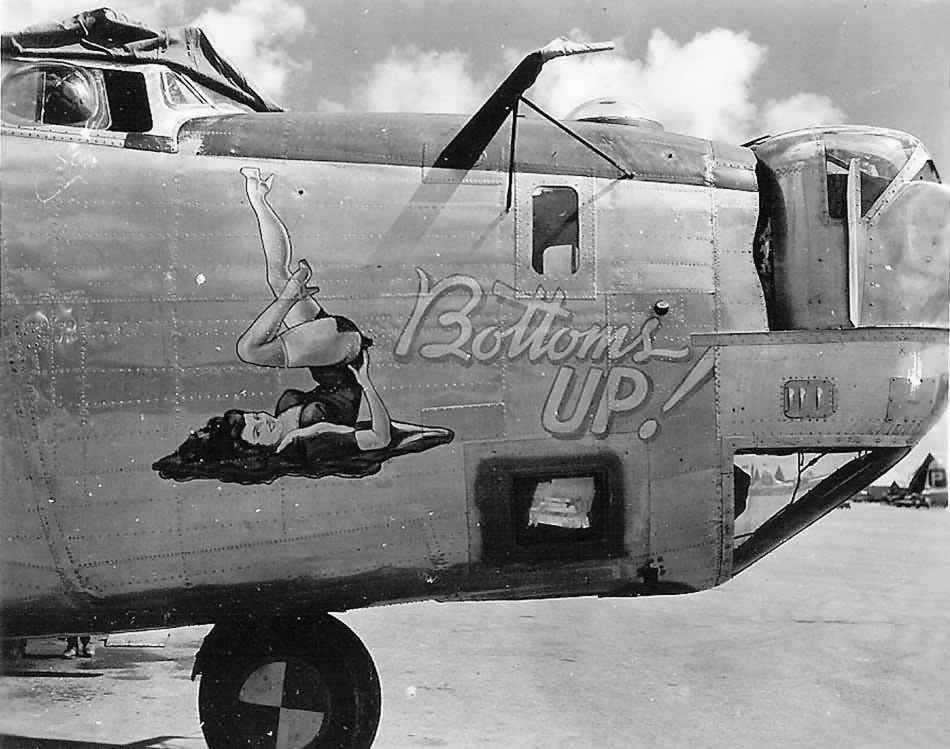
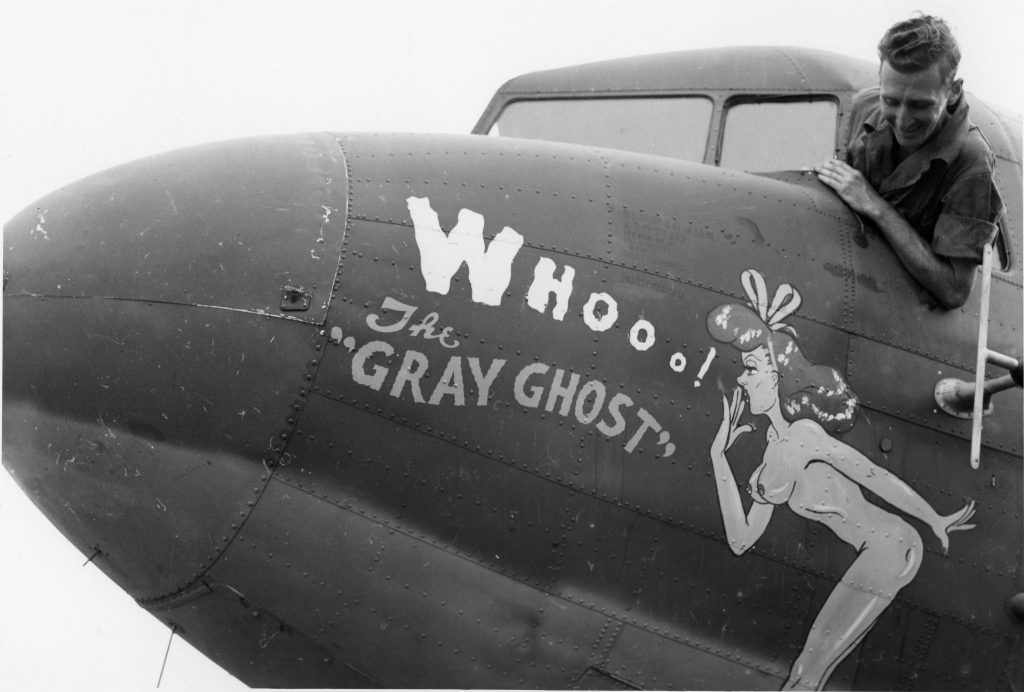
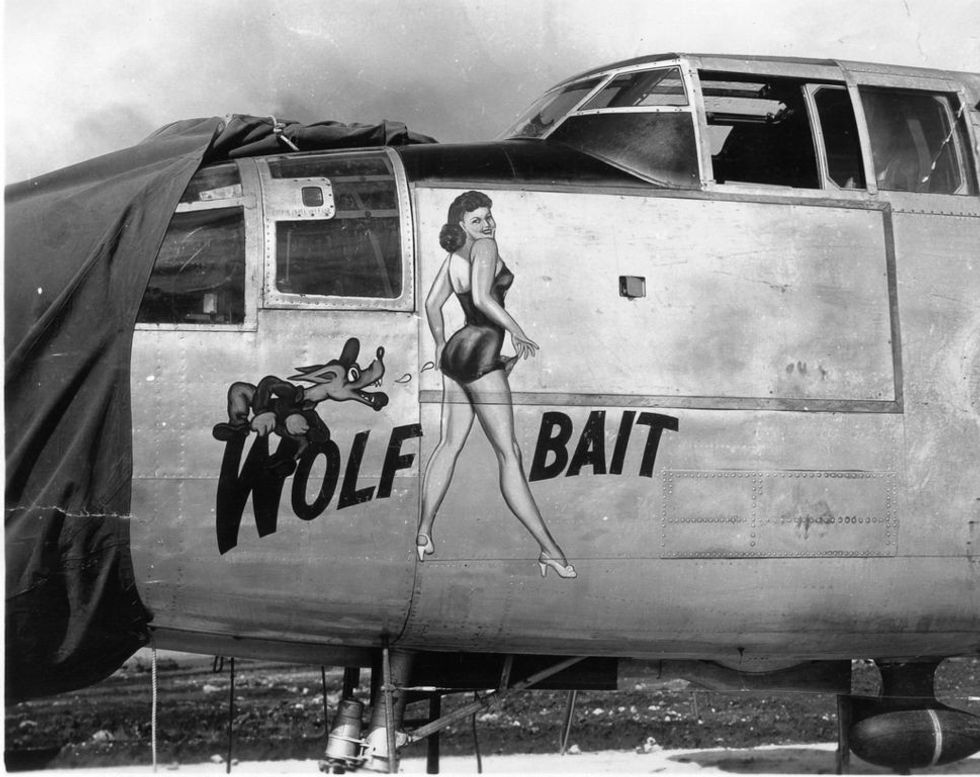
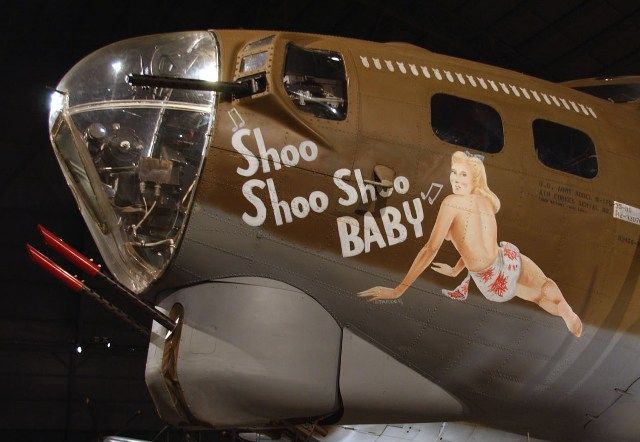
The average age of a bomber crew was 22 years old and they were mostly single. Being away from home, ladies were on their minds. Pin-up girls and provocative female paintings, often half-naked, were matched with memorable names. Some of the nose art was less sophisticated and some more. Many aircraft were also named after wives, mothers, daughters, and movie stars and, as such, any nose art images were very attractive.
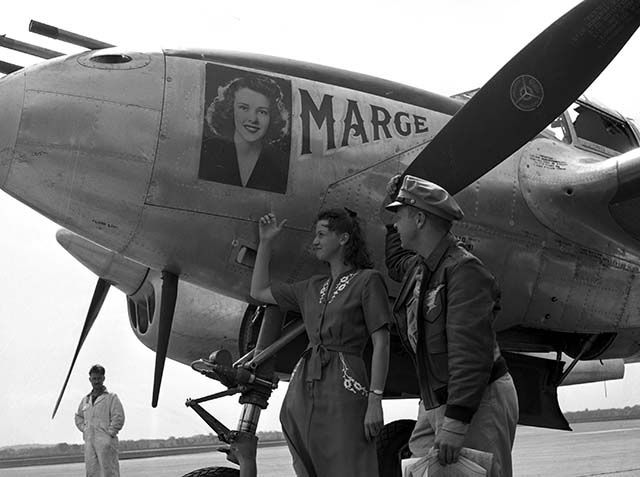
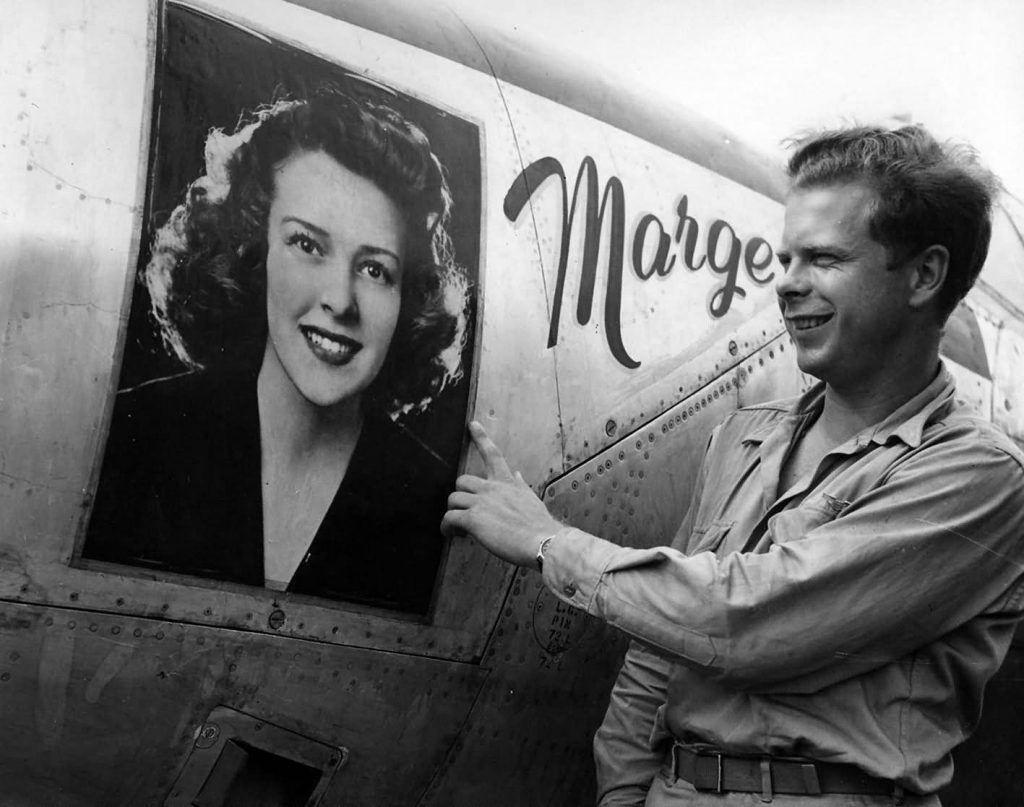
One fascinating example of Nose Art with a real woman’s portrait is the so called “Marge” Nose Art in the pictures above. Major Richard Bong, the USAAF pilot in tribute to his beautiful wife Marge painted her detailed portrait on his P-38 Lightning aircraft.
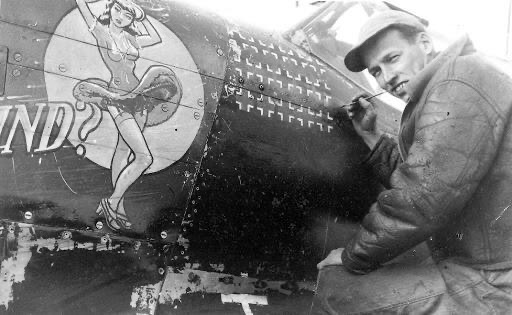
This picture shows the “Ill Wind?” a P-51 Mustang aircraft, and the Nose Art artist Dan Allen painting one of the 15 victories credited to Lt. Nicholas “Cowboy” Megura, near the pin-up girl nose art. 75% of the men who painted these pin-ups, or Nose Art in general, were not trained artists, they just had a natural talent. There were, of course, also a few of them who were trained artists and thus made their sketches famous.
There was lots of pin-up Nose Art painted on American bombers such as B-25 Mitchell known mostly because of the famous “Doolittle raid” – it was the first time in history that a bomber took off from an aircraft carrier heading to Japan. However, one of the best-known pin-up paintings, which has become part of the Nose Art history, is definitely Memphis Belle.
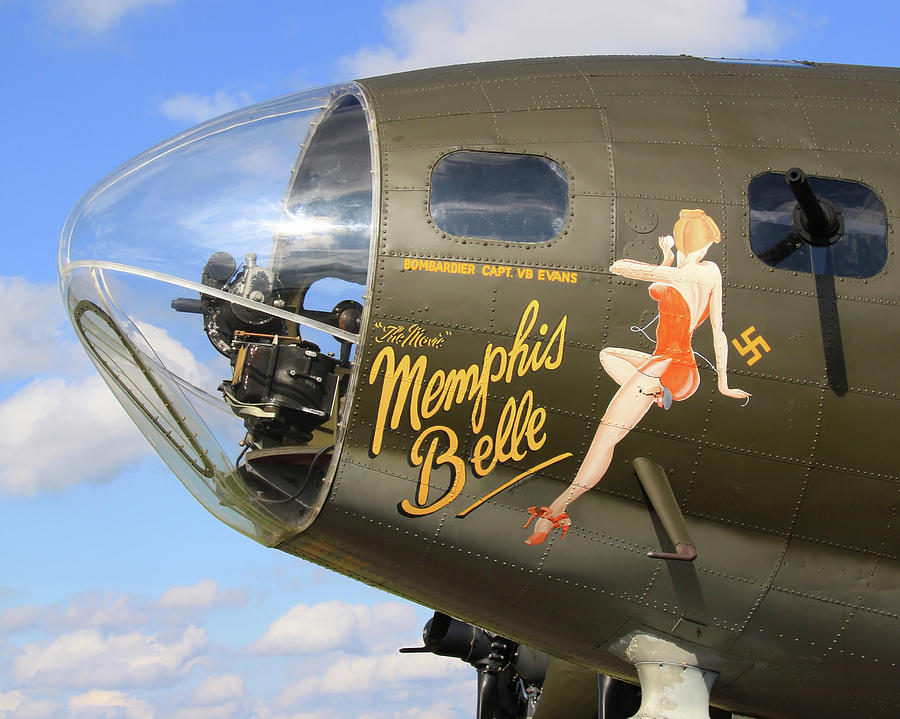
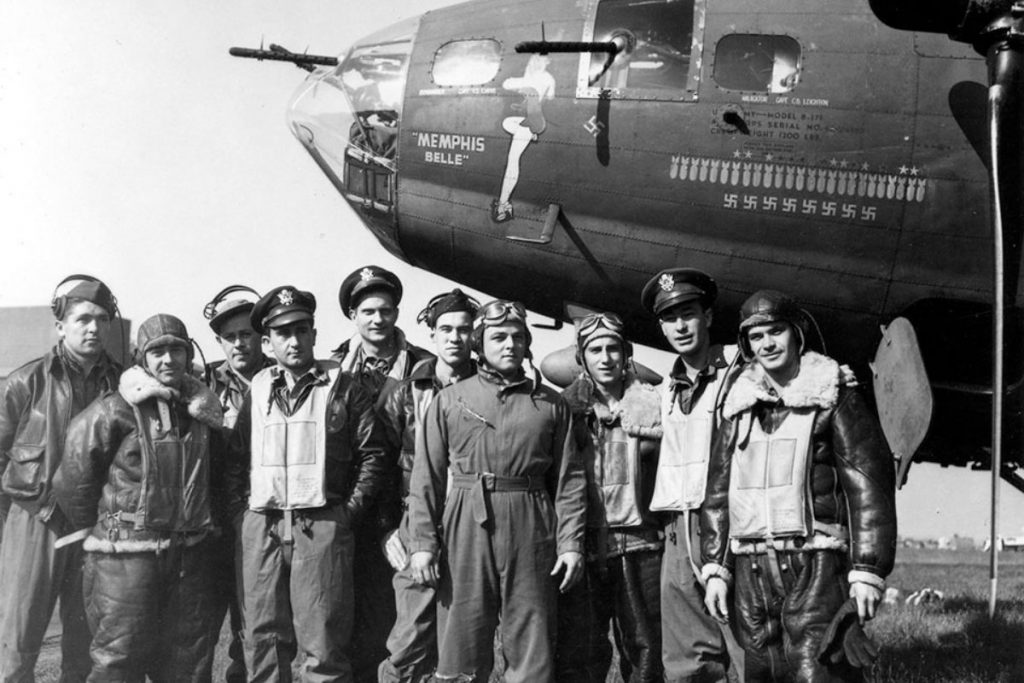
“Memphis Belle” presents a legendary story of an aircraft and a combat unit that was largely promoted by the American media during World War II. The combat unit flew American B-17 bombers (created by Boeing company) and became famous mainly for surviving the last bombing raid against Lorient, a German submarine base, and for completing all of its 25 mandatory military missions and returning to the base with a very successful score. In this picture you can see the whole crew standing in front of Memphis Belle, a Boeing B-17F Flying Fortress. The unit was chosen as a mascot for the US Air Force during the war to emphasize that the soldiers didn’t have to be afraid. If they were diligent enough, followed orders, and fulfilled their tasks, they would survive the war and become heroes. It was also meant to serve as a form of propaganda. Their last legendary mission inspired Hollywood to create a Memphis Belle movie in the 1990s.
The aircraft was named after pilot Captain Robert K. Morgan’s sweetheart, Margaret Polk, a resident of Memphis (Tennessee), to bring happiness to the crew and to protect them during dangerous raids and missions. George Petty, an American pin-up artist was then contacted and asked by Morgan to draw a pin-up girl to go with the name. As we can see in the pictures, Memphis Belle is turned away and therefore doesn’t have a visible face, as if to indicate that she has no specific identity (even though she had). Instead she is meant to symbolize all the women, girlfriends, daughters, mothers, or movie stars of that time. They simply represented a female force to protect them and their safe home return.
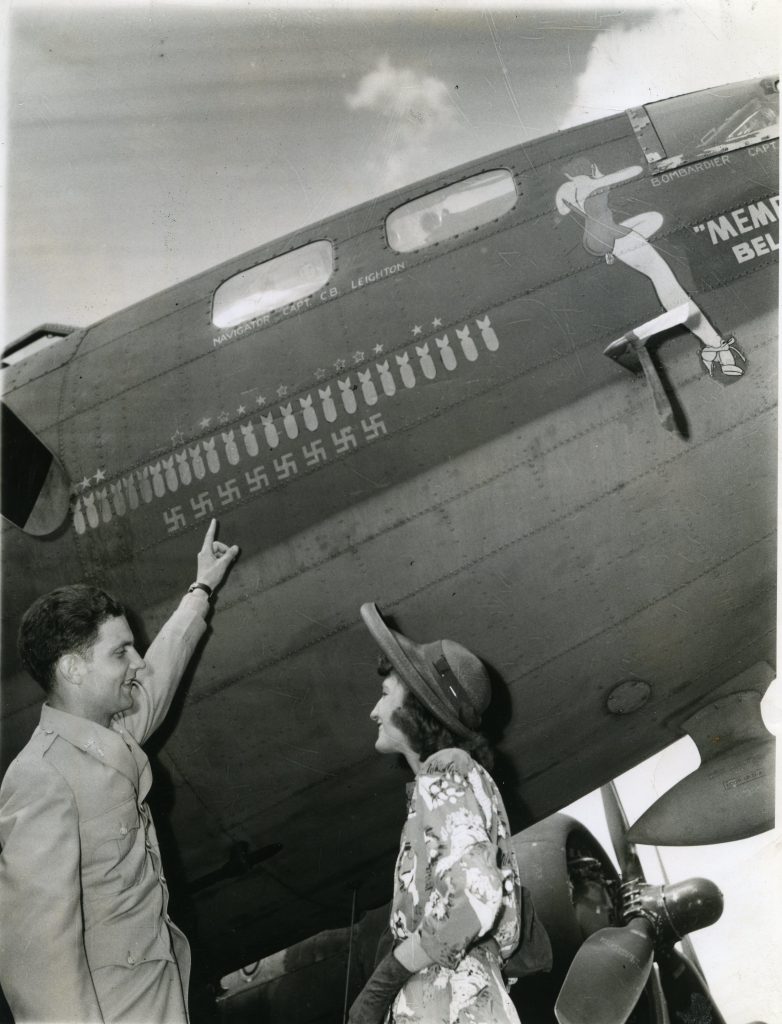
In addition to Nose Art, the aircraft was also marked with the number of enemies that the pilot of the aircraft shot down in air combat. The number of shots was either drawn with bombs or if it was a victory over the German Air Force, the so-called Luftwaffe, a swastika was drawn. The British as well as the Americans used swastikas and bombs as symbols of shooting down enemy aircraft. The number of shots was always strictly controlled because if a pilot painted more shots than he really had he could get a heavy fine or even be sent to a military prison.
A very interesting example is an Avro Lancaster “Leader” Bomber with a Kangaroo wearing flying boots and lustily playing the bagpipes. Besides this Nose Art on the fuselage, there are bombs representing raids over enemy territory and ice cream cones depicting Italian targets. The interesting thing is that this concrete Lancaster bomber still exists and it is airworthy to this day.
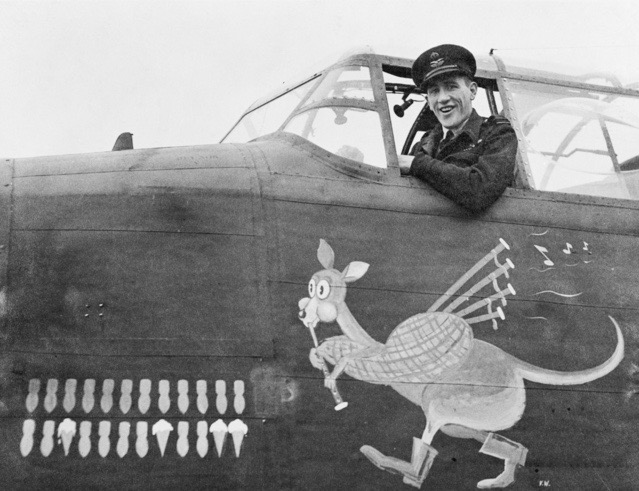
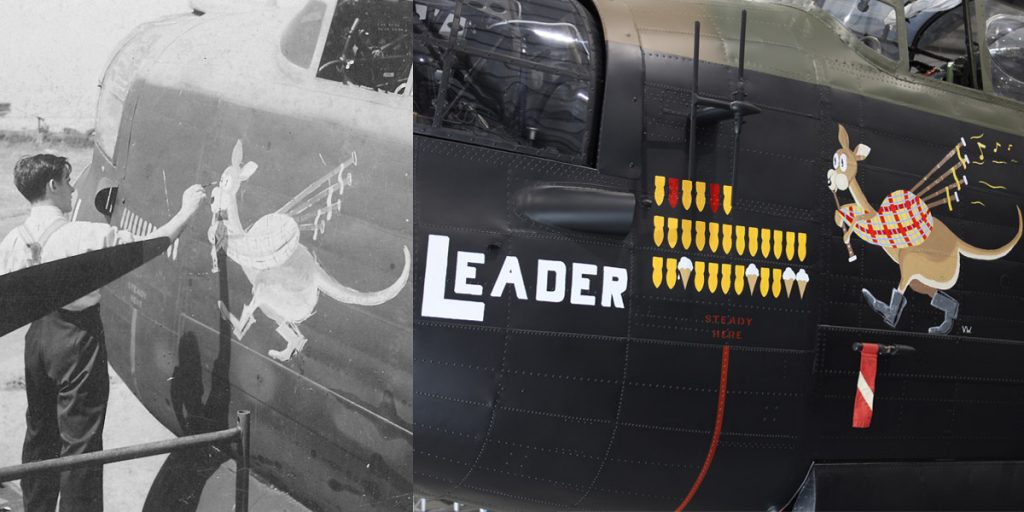
Cartoon figures and other well-known icons (such as the signs of the zodiac) account for another 30 percent of images present on the WWII aircraft. The majority of the cartoon figures trace their origins to comic book heroes and villains, as well as to characters in contemporary cinematic animated features, notably those produced by Walt Disney and Warner Brothers.
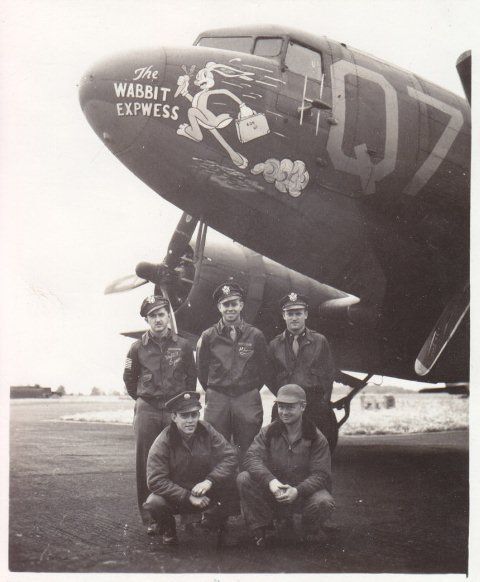
In fact, a lot of cartoon characters from Walt Disney were used in Nose Art design. A very famous example of such Nose Art is the “Medicine Hat”, which has an image of Goofy on its fuselage. The artist was one of the ground crew and he chose to paint Walt Disney’s Goofy dropping bombs. The idea was, that each time the aircraft flew, the enemy was receiving more “medicine from the hat”.
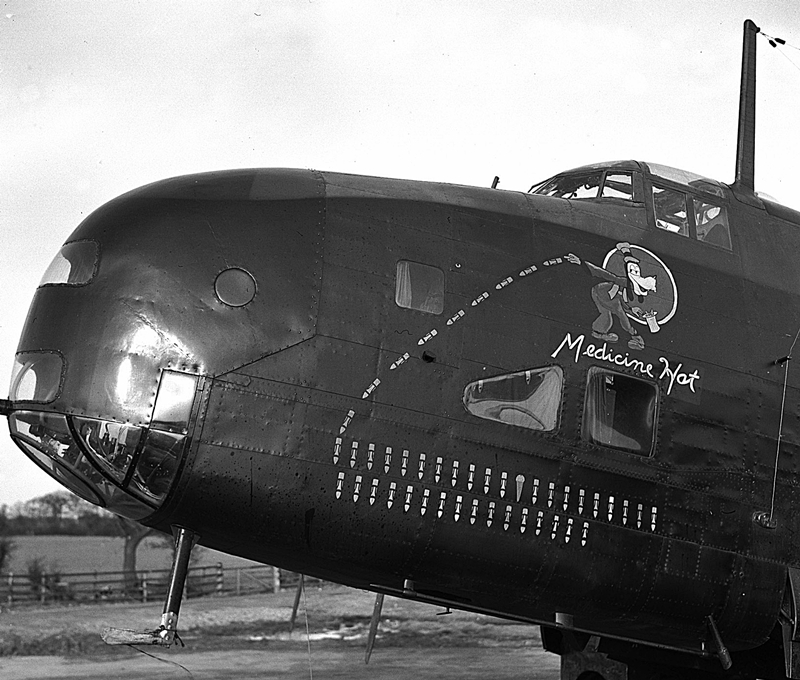
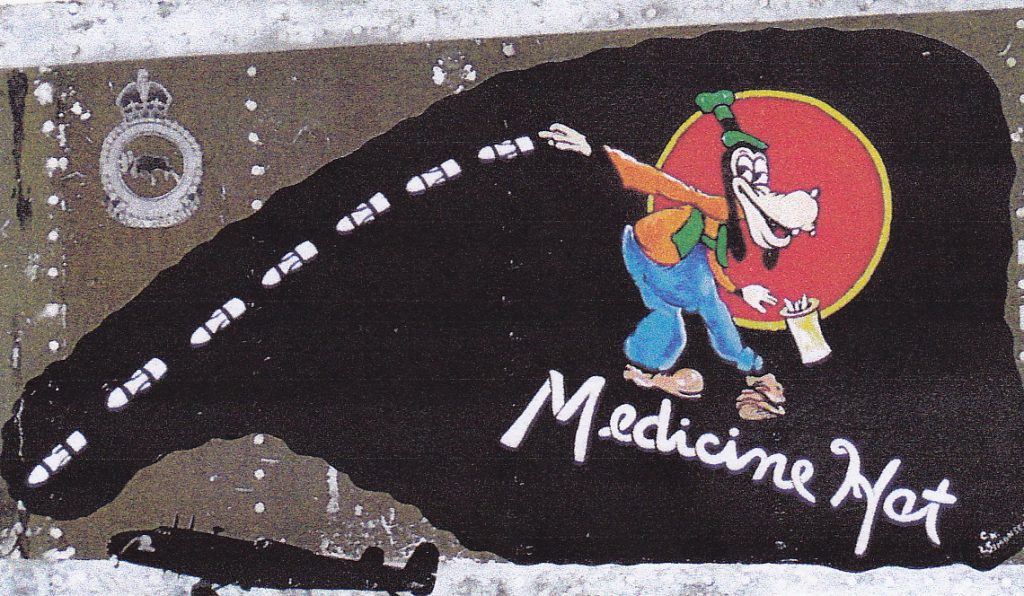
Walt Disney started contributing free of charge. He had five artists that did nothing through the war but create insignia. With his artwork and cartoon characters, Walt Disney had the greatest impact because the young men that went to war had been brought up with Walt Disney’s films.
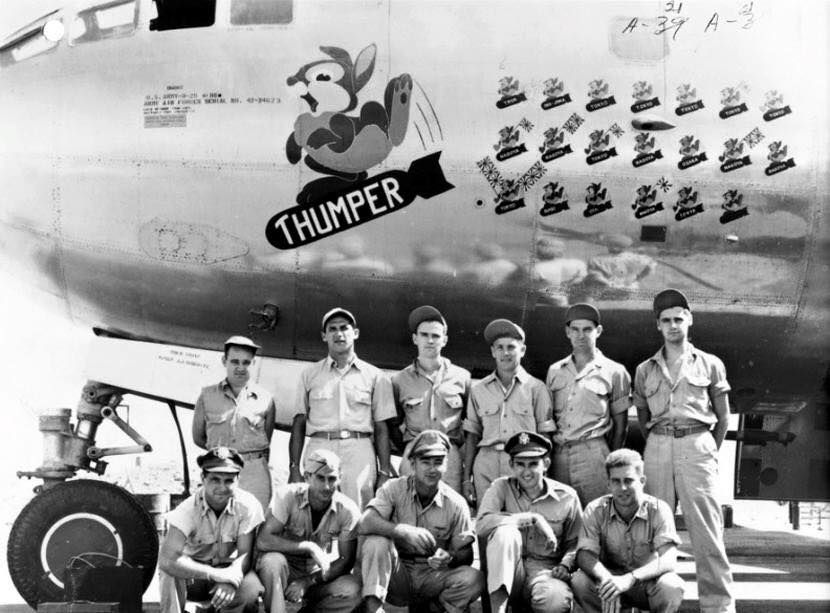
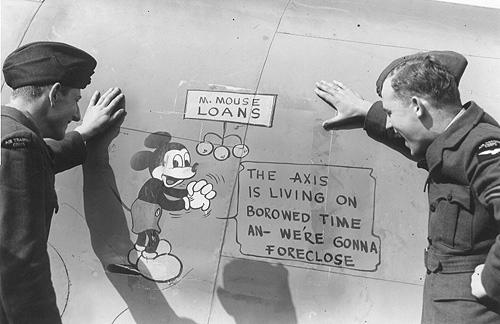
One of the most famous Disney movies at that time was Dumbo. It had a huge impact on the pilots because with his big ears Dumbo was able to fly and thus became a symbol of the aircraft and pilot’s capabilities.
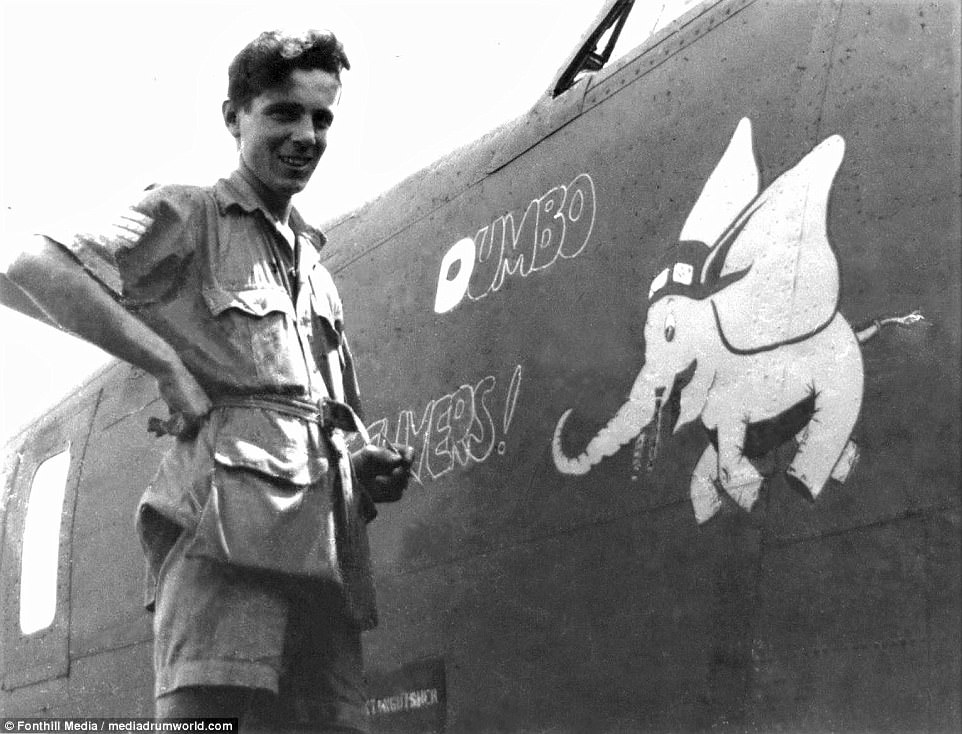
With quite a variety of subjects for Nose Art, this piece is very unique: The ‘Ellcat. It has a direct connection to Hamilton and the Hamilton Tiger-Cats football team. It was painted by Matthew Fergusson, Canada’s best Nose Art painter of that time.
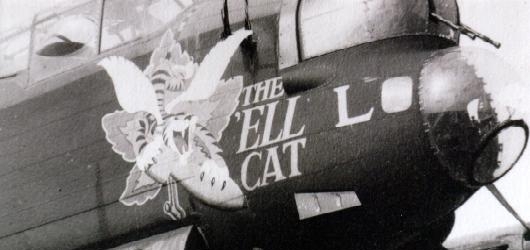
The war escalated and the Americans tried to ridicule the Germans and the Japanese more and more, as evidenced by new forms of Nose Art. These parodied and comically ridiculed Hitler, Germans, and Japanese, in various comics or Nose Art versions. As it was also a form of strengthening one’s self-confidence.
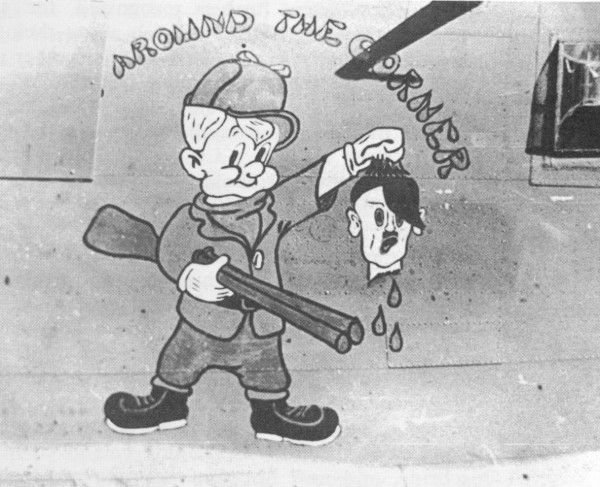

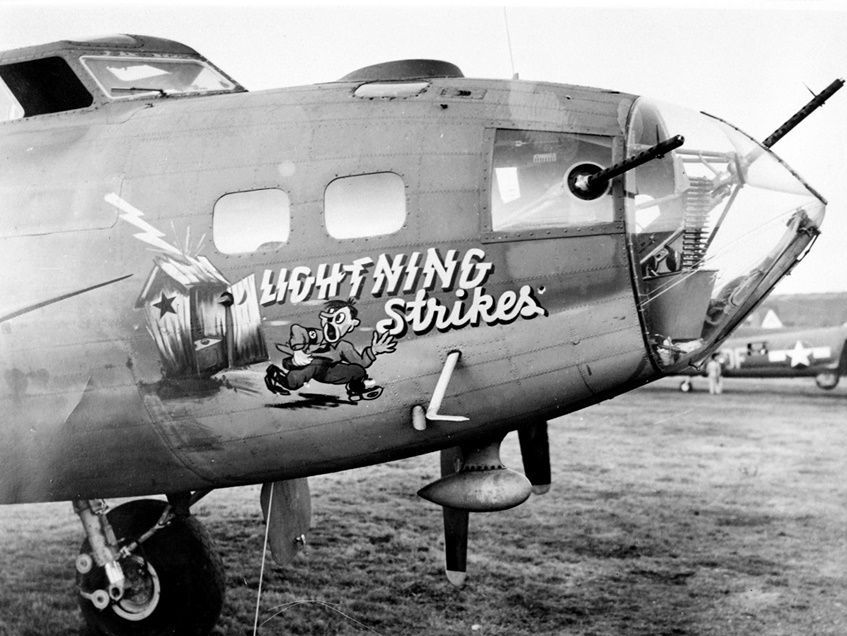
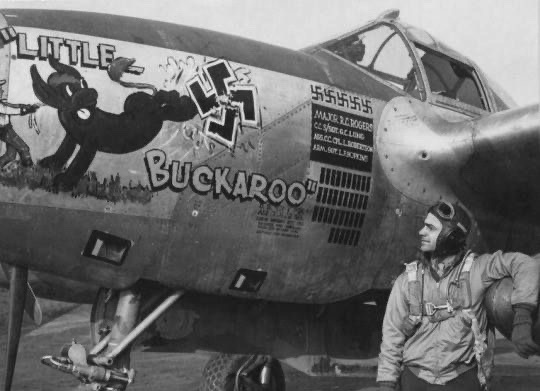
The last picture shows pilot Major R.G. Rogers looking at his Nose Art called “Little Buckaroo”. Here an American cowboy tames a bull (his plane) and shows how he kicks the ass of the Germans represented by the swastika sign.
At the very end of World War II the United States made two last bomb attacks on Japan in order to force them to surrender. Two of the most famous of B-29 Superfortress bombers were sent: the first was commonly known as Enola Gay, which dropped the “Little Boy” atomic bomb on Hiroshima, and the second was called Bockscar.
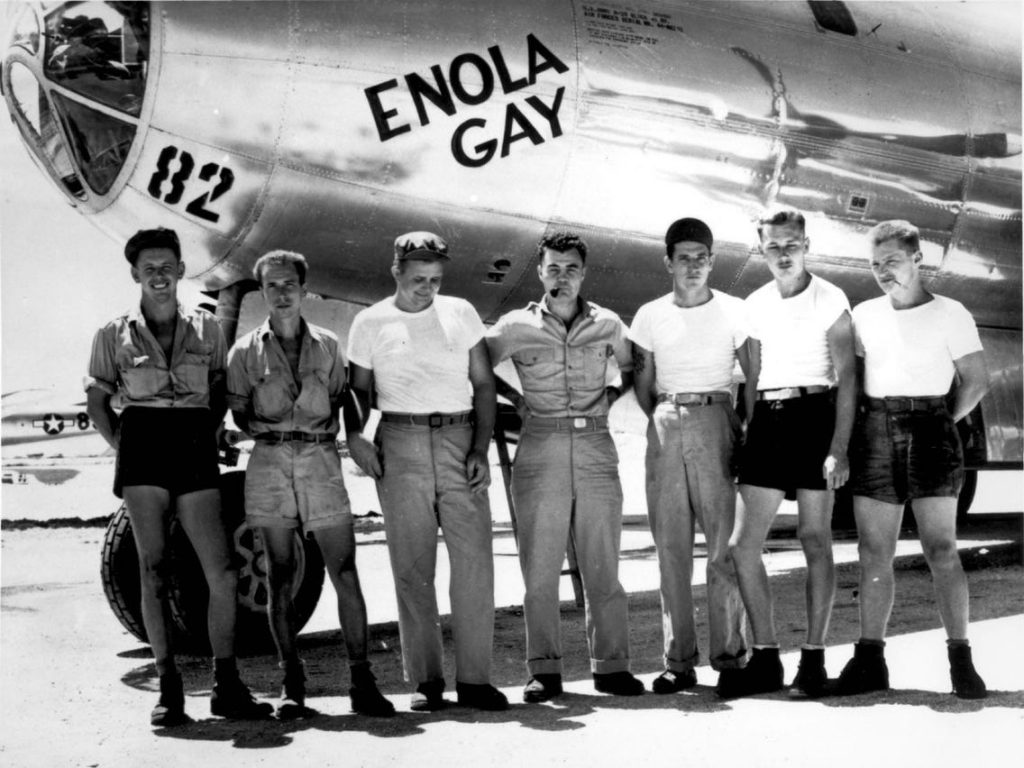
The American Bockscar bomber, nicknamed for its assigned pilot Fred Bock, was one of the two most famous Boeing B-29 Superfortress bombers. On August 9, 1945, they victoriously ended the war with Japan, attacking and dropping an atomic bomb called “Fat Man” on the Japanese city of Nagasaki. It was the highest version of the bomber which the United States created during World War II. It was also the aircraft that ended World War II overall. On side of the aircraft was painted this piece of famous Nose Art:
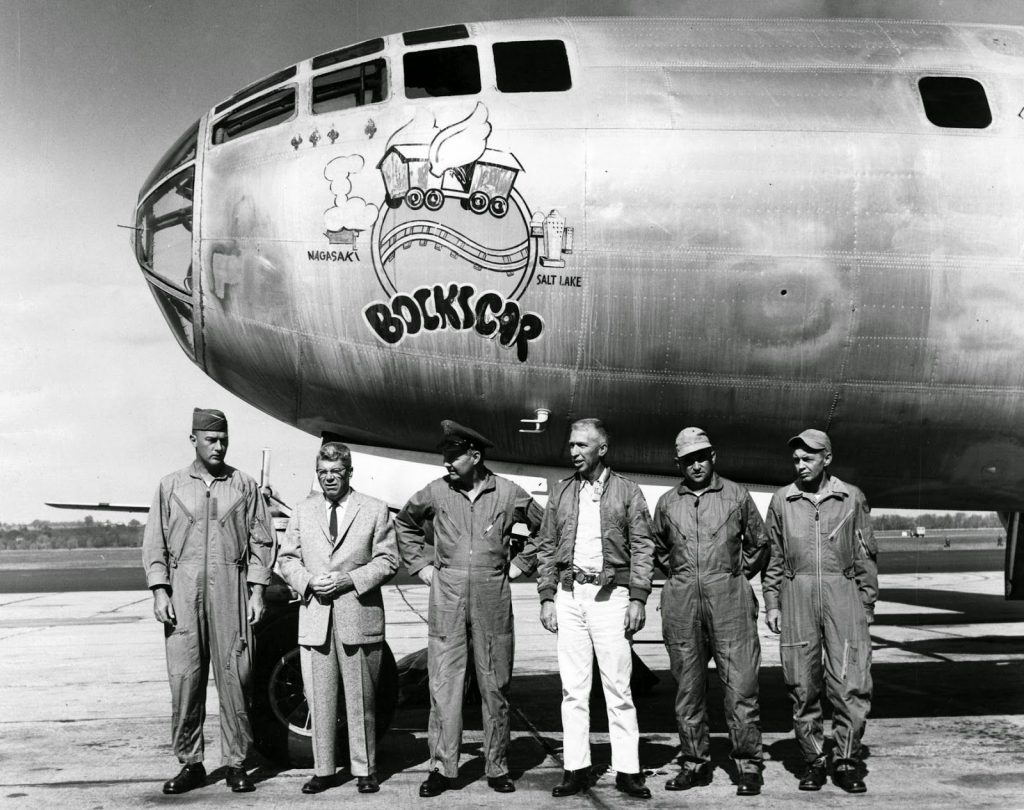
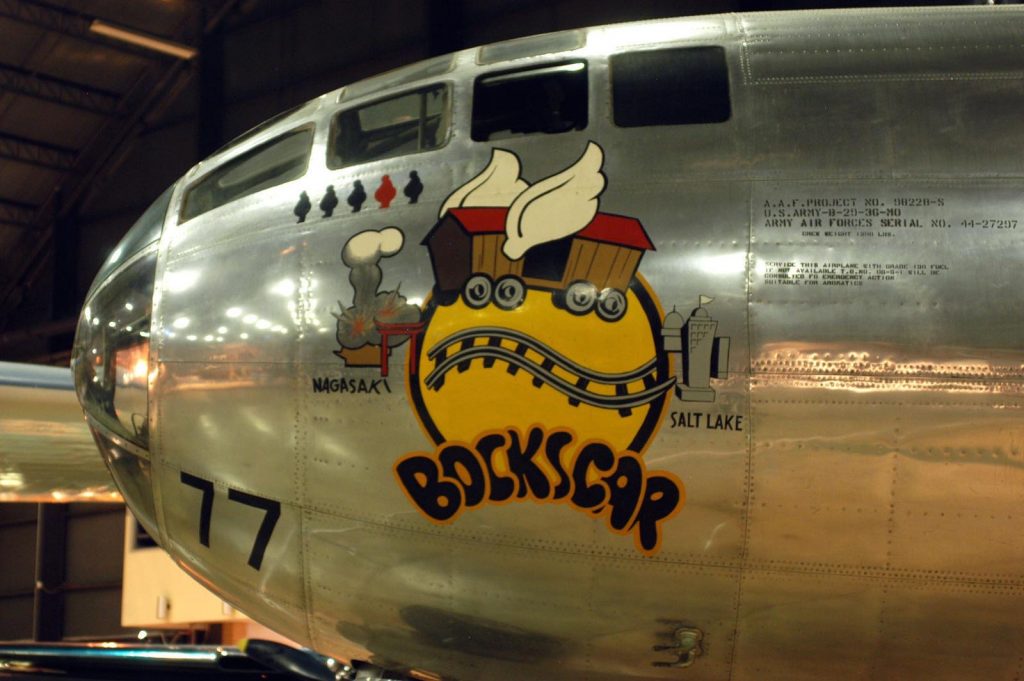
This wagon, which symbolized a wagon in which the Germans transported Jews to death camps, is winged. It was going to deliver an atomic bomb from Salt Lake to Nagasaki (the bomb is visible above the Nagasaki inscription in its typical “mushroom” form but also higher as the red Fat Man). The inscription ‘Bockscar’ below the painting is very similar in style to graffiti and this is one of the reasons why Nose Art is still considered the forerunner of graffiti.
The word “ephemeral” is an accurate description of wartime Nose Art. This is a word that describes something that lasts or is used for only a short period of time. It was a fact of war that an aircraft would be lost either by accident or in combat. Therefore the preservation of any Nose Art was the least important concern of commanders who needed every aircraft and aircrew. The end of the Second World War sent thousands of aircraft to the scrap yard. A few scattered attempts were made to salvage the art before cutting up the rest of the air-frame and the end result is that there are few actual examples of this art in existence today.
After the Second World War, the tradition of Nose Art in the aviation industry has been preserved to this day in various forms and uses. We can admire restored paintings that were saved from the Old WWII aircraft or new forms of Nose Art in the civil sector of aviation, on fighter jets, or on remodeled historic aircraft that can be seen in flight demonstrations during organized aviation days.
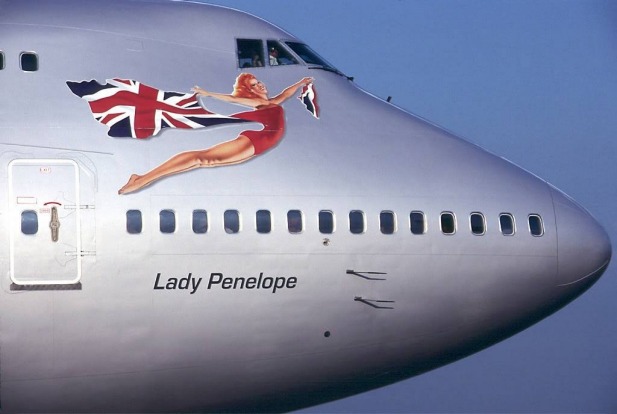
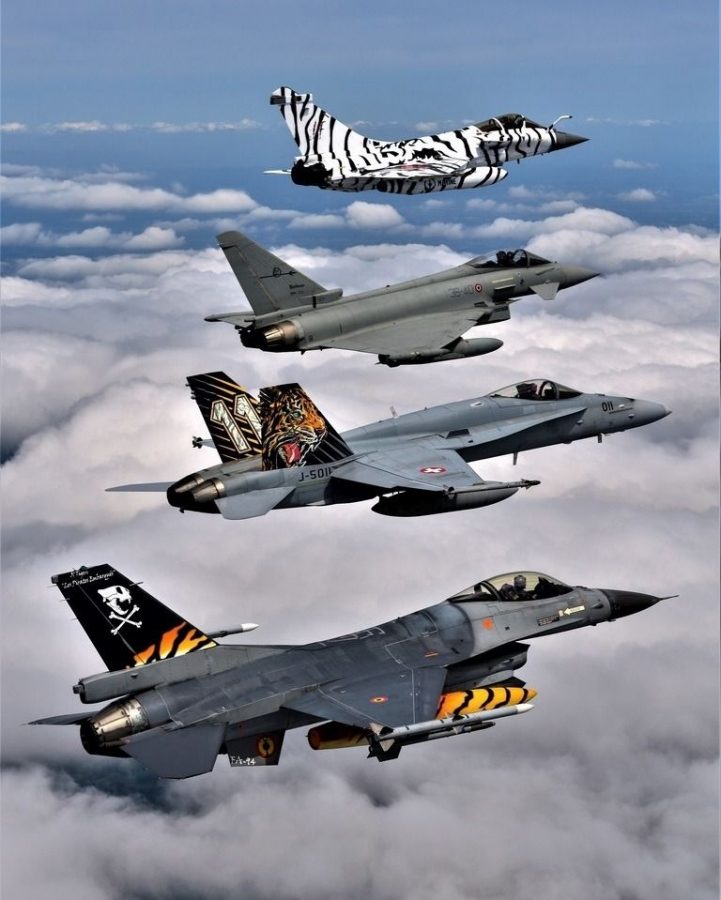
Contemporary Nose Art is often thematic and can celebrate a round anniversary, or symbolize military history. Meanwhile, in the civilian sector it can be used as a form of advertising. It is possible to see Nose Art on civil aircraft with a film theme or with the theme of product advertising campaigns or marketing news. Examples of such are the Japanese Airlines Ana with Star Wars decoration or New Zealand Airlines with characters from the movie Hobbit sprayed along the entire length of the aircraft.
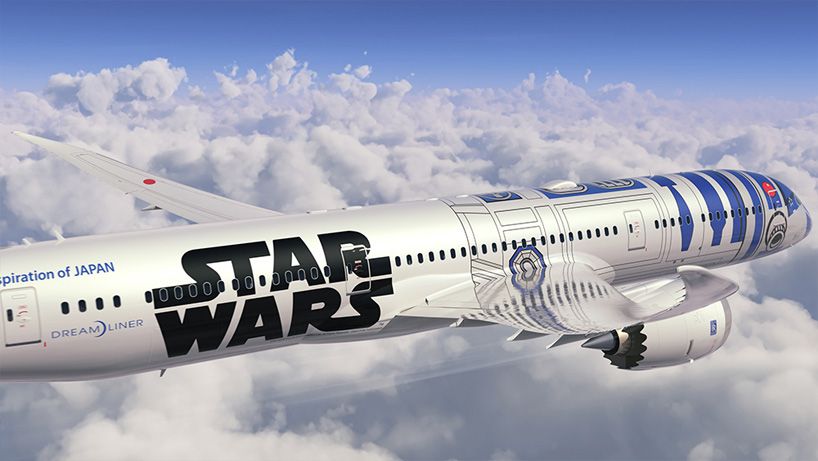
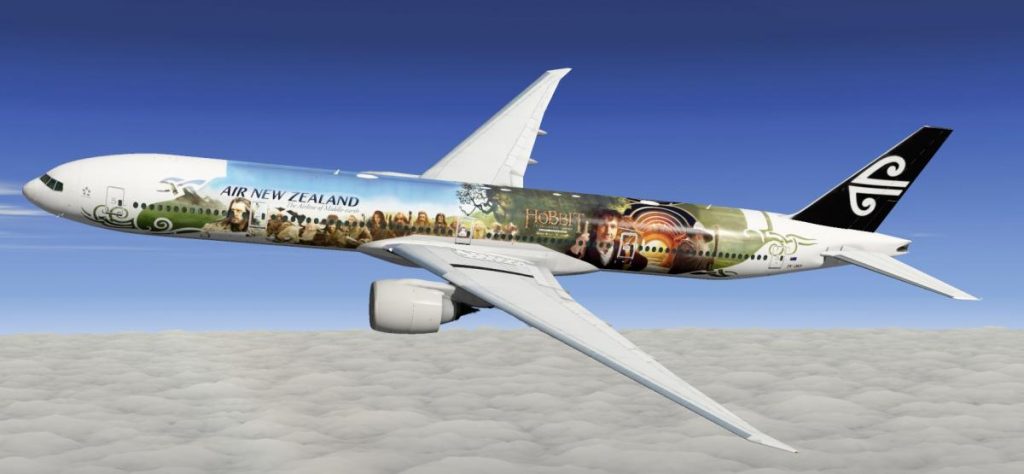
There are also Nose Art competitions all around the world. In these various artists try to create their own, personalized Nose Art by spraying it on the fuselage. The one which is the most liked by the jury wins.
In terms of historical preservation of this tradition, the greatest pioneers and maintainers of Nose Art are the historic-modern Austrian air unit Flying Bulls, owned by Red Bull. Red Bull has a private collection of historic WWII aircraft. These warbirds are presented at various air shows and their “nest” is in the beautiful Austrian Hangar-7. Here they are displayed and can be seen by visitors and passionate enthusiasts. Well-trained Red Bull pilots try to fly air demonstrations with their planes so that they look authentic and at the same time the planes themselves look authentic.
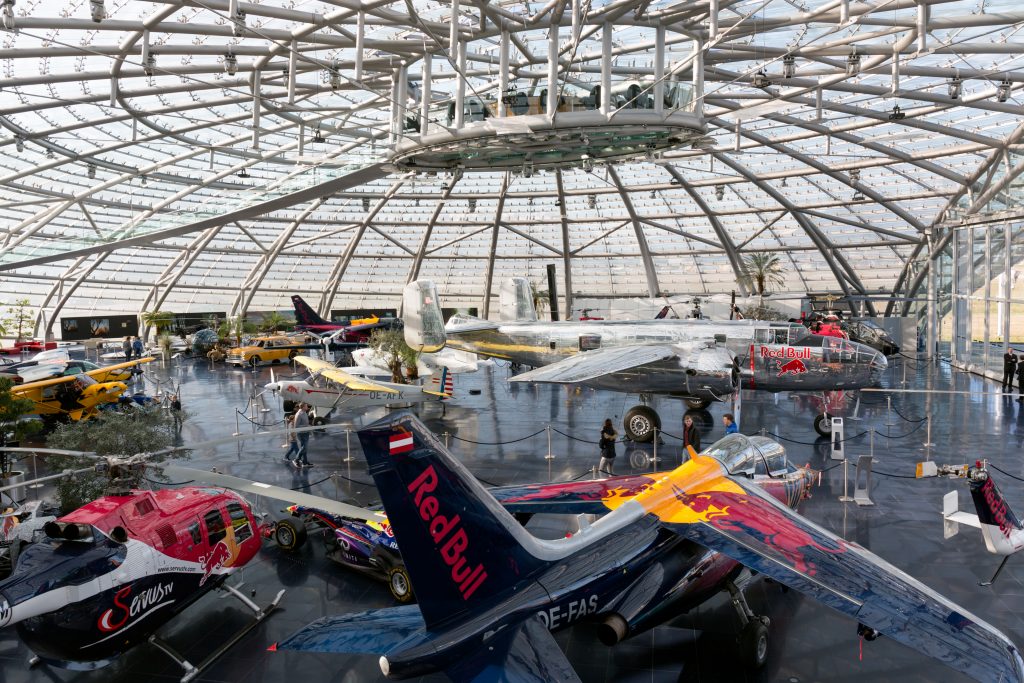
The exact appearance of Nose Art has changed to a modern form of advertising for the Red Bull brand itself. It has replaced political propaganda for the opportunity to present a product, advertise and market it through either modern or historic aircraft. They exchanged the propaganda for advertising. Today, the form of modern Nose Art is on Flying Bulls aircraft. However, as it is privately owned by one of the richest companies in the world, Red Bull, it is primarily Red Bull’s marketing which still strives to preserve Nose Art’s tradition, although in a modern form. Recently Red Bull’s historic WWII airplanes, P-38 Lightning and B-25 Mitchell bomber, were “tattoed” with their own Nose Art combining the brand’s main logo with the typical pinup girl.
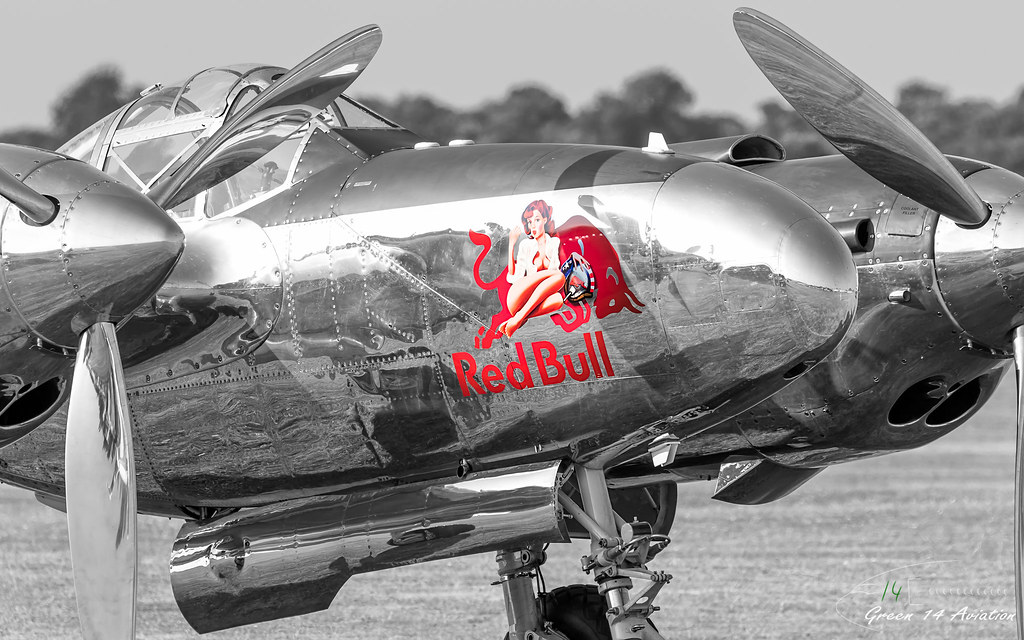
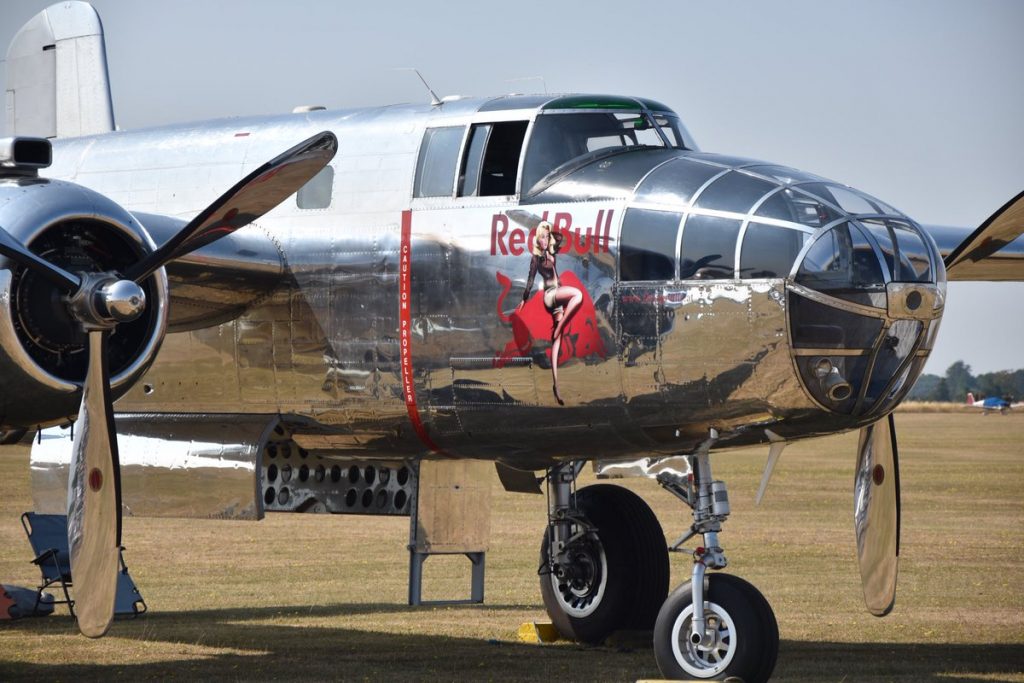
While it may not be “real art” it is certainly more than graffiti. It is a kind of folk art that provides a unique insight into the mindset of the aircrew and ground personnel who were thrust into an environment where the only certainty was the uncertainty of their survival.
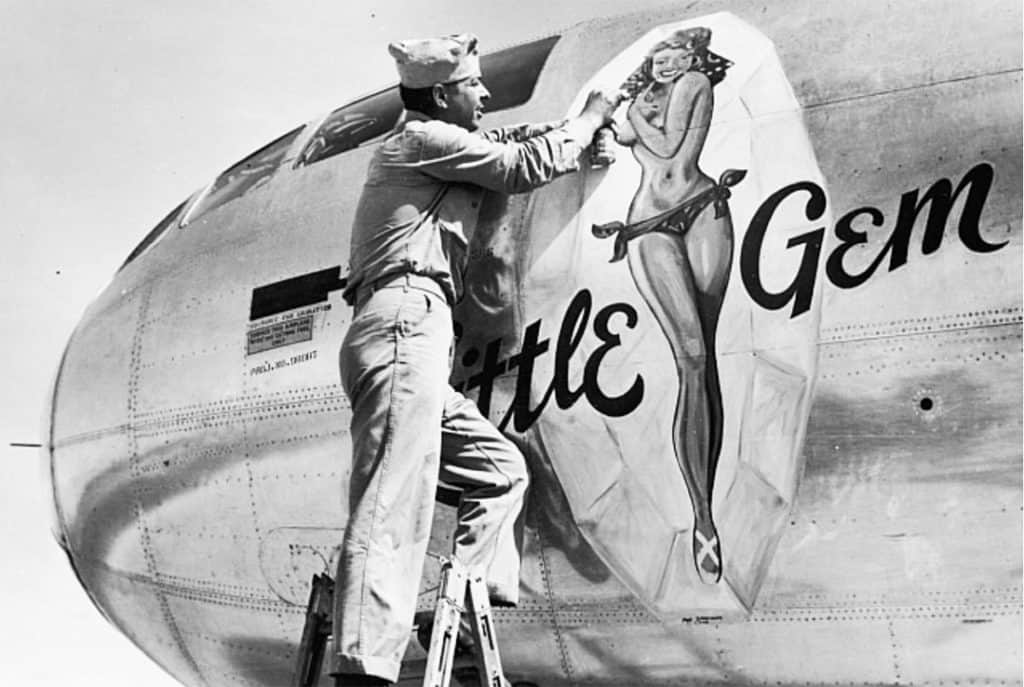
We often find out what Nose Art looked like only because of the story of who painted it. Successful Nose Art goes hand in hand with successful pilots who have made that particular Nose Art famous. Only thanks to the skill of the pilots and their efforts to survive and fight for their homeland, were they able to preserve the works for future generations. Nose Art that was originally intended only to help them enjoy themselves and overcome the difficulties of war, nowadays for many represents a form of modern art that they admire.
DailyArt Magazine needs your support. Every contribution, however big or small, is very valuable for our future. Thanks to it, we will be able to sustain and grow the Magazine. Thank you for your help!